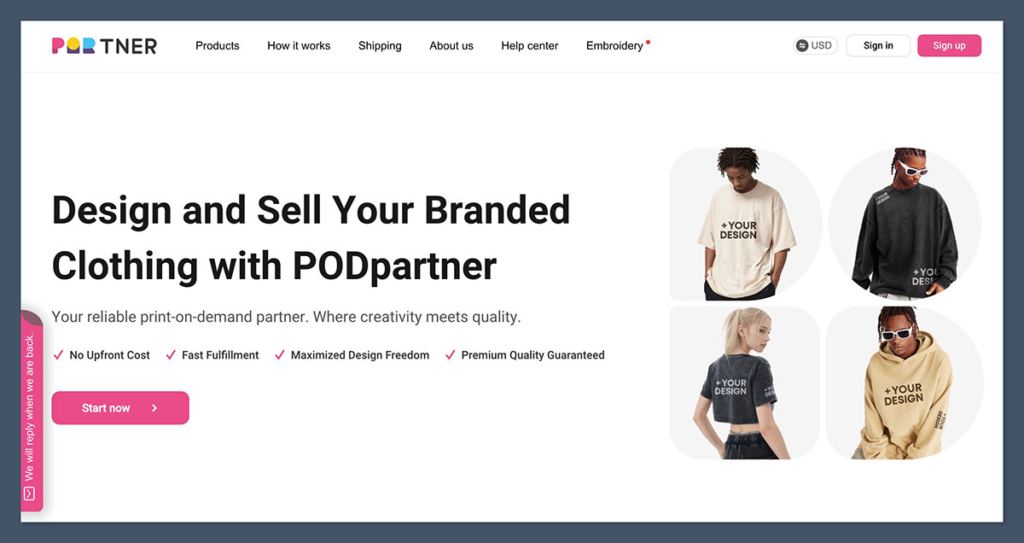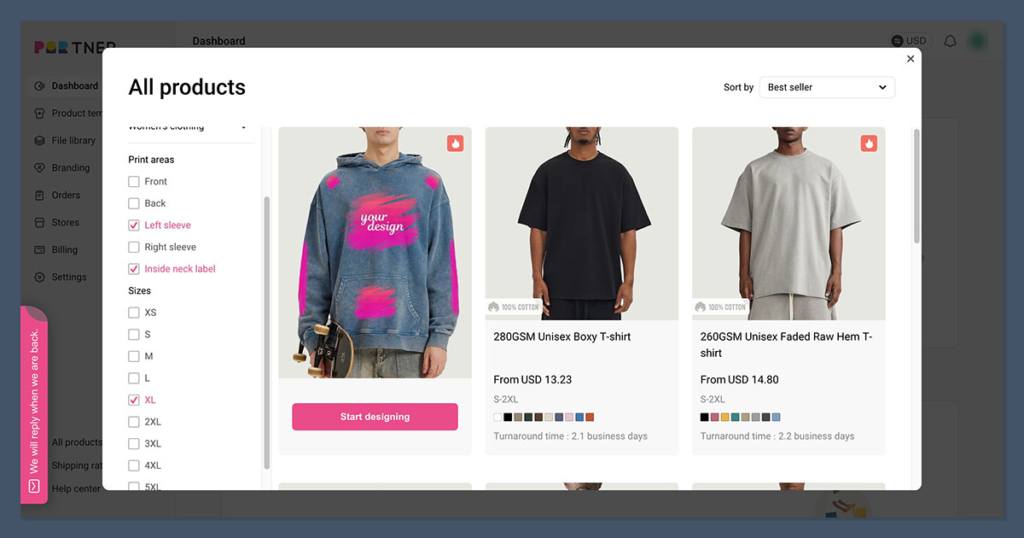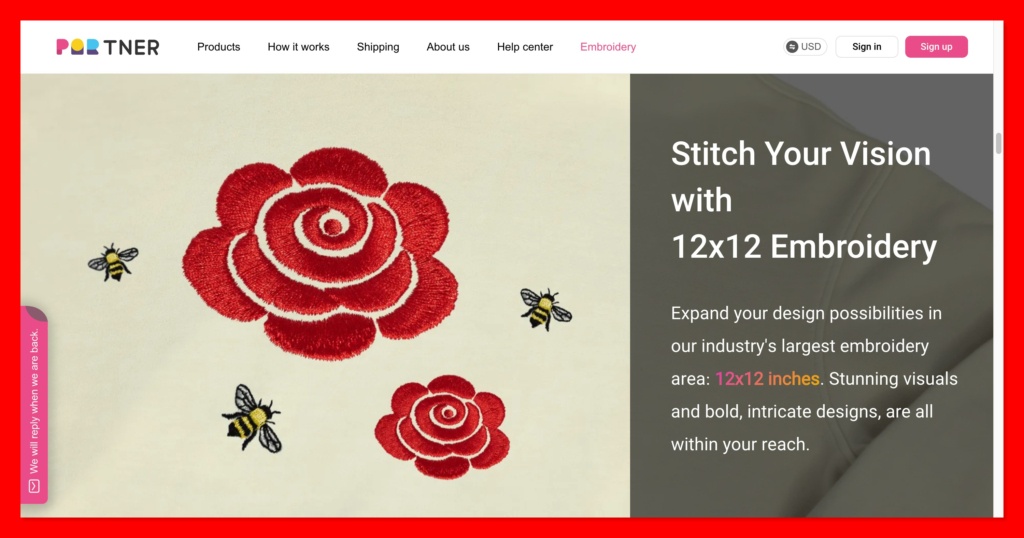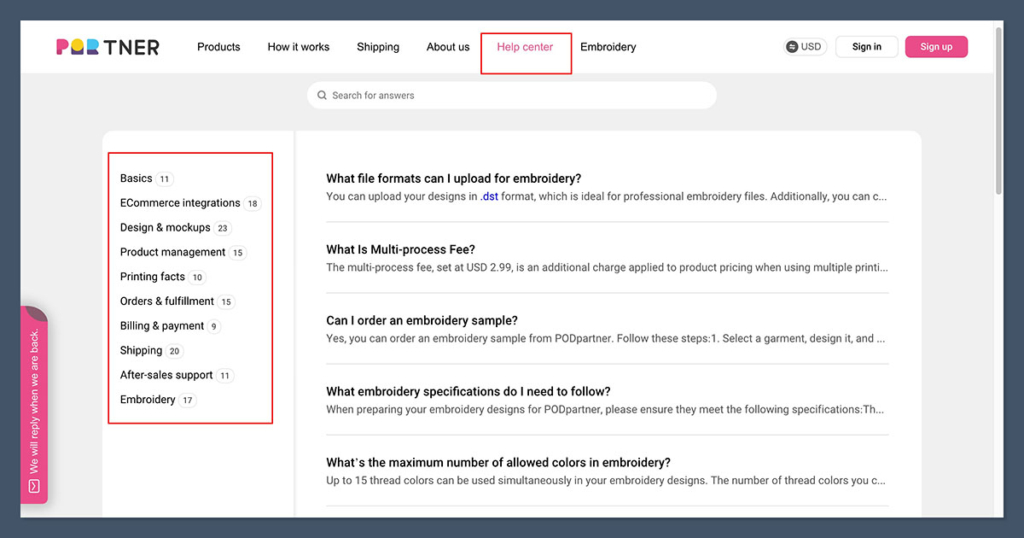
Ten years or so ago I’d never heard of print on demand (POD).
Now, I’ve lost count of the number of POD solutions I’ve explored. You’re probably already familiar with some of my top picks, like Gelato, Printify, and Printful – but today I want to introduce a new alternative: PODpartner.
Launched in 2019, PODpartner is one of a surprisingly low number of POD companies that seems to really know what it’s audience is looking for.
Sure – it doesn’t have as much variety as some alternatives in terms of product options, but it prioritizes product quality, customization options (particularly from an embroidery perspective), and sustainability.
In just a few years, it’s taken the POD market by storm, particularly focusing on fashion-first brands looking to create unique, trending clothing.
Here, I’m going to share my hands-on experience with PODpartner, to help you decide whether it’s the POD service you’ve been searching for.
Quick Verdict: Pros and Cons
I’ll be honest, compared to some of the POD solutions I’ve tried, PODpartner has a couple of downsides. It has a slightly smaller product range – since it focuses exclusively on apparel.
So you can’t create things like stickers and mugs.
It also doesn’t integrate with quite as many sales channels as some alternatives. Plus – it’s not particularly well known (at least not yet).
But those drawbacks are pretty small when you consider the benefits you get.
PODpartner delivers premium-quality garments that outshine the competition in most areas. In fact, they’ve earned some fantastic reviews for the material quality alone.
They’re also a sustainable brand, with a focus on flexible customization (I’ll talk more about that later in this review).
If you’re looking for the ultimate sustainable fashion partner, PODpartner is a great choice.
Pros:
- Eco-conscious approach
- Large design and embroidery areas
- Transparent, free-to-use model
- Responsive in-house production
- High-quality garments
- Lots of apparel options to choose from
Cons:
- Fewer products than some alternatives
- Limited integration options
The Core Features

PODpartner is (as the name might suggest) a print on demand company, that began life as a wholesale apparel manufacturer in 2013.
Over time, they decided to branch into the “custom clothing” landscape, with a focus on igniting the creativity of designers, and boosting sustainability.
When I say PODpartner gives you a lot of creative freedom, I’m not kidding.
It offers some of the largest design areas for clothing I’ve seen (both for printed garments and embroidered products). It also gives you lots of different print areas to choose from.
Plus, you get premium-quality cotton fabric for most items, and global shipping. There’s even the option to offer customers “faster” or “Express” shipping in most regions.
Let’s dive into the basics of what this platform offers.
Product Variety and Printing Options
As I mentioned above, if you’re looking for a bunch of different types of products, like prints, stickers, and drinkware, PODpartner might not be the best pick.
It focuses on its area of expertise: apparel – so you can really only create custom clothing.

Still, there are plenty of great options to choose from, ranging from hoodies and sweatshirts, to t-shirts made with premium cotton.
You can even create shorts, pants, and tank tops. The great thing is that PODpartner also produces items in line with the latest fashion trends.
So you don’t just get a generic hoodie – you can choose between fleece-lined options, oversized retro options, faded hoodies, and so on. That’s more than you get from most alternatives.
The customization options are excellent too.
You can choose from DTG printing, or embroidery – and with both options, you get ultra-large design spaces.
You can even choose from up to 18 print areas on a single garment. Typically, with many other POD platforms, you’re limited to the front, back, and maybe a sleeve.
The actual embroidery is incredible too – you can incorporate up to 15 thread colors in a single design (which is more than most alternatives offer).

Even better, you can actually combine DTG printing and embroidery on the same garment – giving you yet another way to make your products stand out.
One slight caveat is that currently, PODPartner only supports DST files for embroidery – but their digitization feature is in development.
Plus, if you already have DST files, you won’t have to worry about paying any extra digitization fees.
PODpartner’s design tools are pretty similar to most of the other options I’ve used from similar vendors – with a few caveats.
Although you don’t get any AI-powered image generators, you do get separate design systems for DTG printing and Embroidery – so you can really make the most of the print method, and create some amazing mockups.
Everything is really straightforward and intuitive, whether you’re adding images, adjusting text, or shifting your design to different spaces on a garment.
Product Quality and Branding Options
After ordering samples from literally dozens of POD vendors and marketplaces, I have to say I’ve come across far too many cheaply-made products.
Questionable stitching, subpar materials, and blurry prints are all too common (particularly among cheaper vendors).
PODpartner really does focus on quality.
It’s not just that they use premium cotton in most of their products.
They also implement robust quality assurance methods, and produce most of their items in-house, rather than outsourcing to unreliable third parties.
Another major plus is their eco-friendly approach – they prioritize non-toxic inks, sustainable, durable materials, and minimal waste.
All of this makes it easier to actually charge a premium price for your products that customers are willing to pay.
From a branding perspective, PODpartner offers a few different options, like custom labels, neck tags, and packaging bags.
If you’re serious about building a memorable brand, these details do make a difference.
In terms of overall packaging, they keep it relatively minimal but clean, which fits the eco-conscious theme.
If you’re looking to stand out with your own finishing touches, the platform provides an easy route for that.
Sales Channels and Fulfillment
For me, a critical aspect of any POD service is how smoothly it connects to my store, and how quickly the company can get orders out to customers.
Compared to alternatives like Printful and Printify, PODpartner doesn’t offer the biggest range of integration options.
So far, you can connect the platform to Shopify, Etsy, Squarespace, WooCommerce, and Wix.
That might not seem like a huge collection – but it covers all of the biggest mainstream ecommerce platforms. Plus, there’s every chance that the company might introduce more integrations going forward.
Once you’ve connected your store – on the plus side – automating order fulfillment is really straightforward.
In terms of fulfillment, PODpartner works with world-leading logistics companies to help you reach customers quickly around the globe.
They offer standard, fast, and express shipping options for most regions (With clear and transparent rates you can find here).
With Express shipping, US customers can receive some of their orders (like custom t-shirts) in around 3 days – which is impressive.
Obviously, delivery times vary depending on what you’re ordering, the level of customization, and where your customers are – but PODpartner aims to keep things moving quickly.
98% of orders are processed and shipped within 48 hours of the order being placed. Just remember that a completed order doesn’t necessarily mean a package on your doorstep – they still need to make the item first.
How Much Does PODpartner it Cost?
Unlike some of the other POD platforms I’ve mentioned in this review (Gelato, Printful, and Printify), PodPartner doesn’t have any “paid plans”.
It doesn’t differentiate between customers who are willing to pay a monthly fee, and those that aren’t. Everyone gets access to the same features, for no upfront costs.
All you need to pay for is the actual base cost of the product – which means your profits depend entirely on your pricing and how much you sell.
If you’re worried about base product costs – PodPartner excels from that perspective too.
For instance, the cheapest t-shirt you could buy on Printify (with a premium plan subscription) would cost you around $7.70 (for the 153GSM option). PodPartner’s comparable 150gsm t-shirt starts at just $5.89.
A heavyweight t-shirt on Printify (240GSM), would cost you $18.79 with a premium plan, whereas PodPartner’s heavyweight t-shirt is just $14.80.
That means with PODPartner, you get cheaper upfront prices straight away, without even having to spend some of your profits on a monthly plan that promises “extra discounts”.
Even when you add extra elements like embroidery and flexible designs, the prices remain remarkably low.
Shipping prices are pretty standard compared to what I’ve seen throughout the POD market too – so even if you want to give your customers free shipping, you can still benefit from huge profit margins.
One extra thing to watch out for, though, is the “multi-process” fee (around $2.99). This is applied whenever you combine multiple decoration methods, such as DTG + embroidery.
While it isn’t the cheapest add-on, it covers the complexity of running garments through different production lines.
Even with this add-on, PodPartner’s prices are some of the most competitive in the market.
Ease of Use and Customer Support
Whenever I test a new POD platform (particularly when I’m considering recommending it to others), I like to pay close attention to ease of use and customer support.
If you’re a beginner to POD, the good news is that PODpartner is very easy to use.
You can sign up for an account in a couple of seconds, create products in minutes with the intuitive “Design Creator” tool, and add them to your integrated website in no time.
Though the design interface was mostly smooth, it took a little while to get used to toggling between printing and embroidery features.
Fortunately, you won’t really need to worry about this until you start experimenting with more complicated designs. There are also plenty of FAQ guides and tutorials on PODpartner’s website to help you.

Speaking of support – while the Help Center is great – you are limited on the number of ways you can actually get in touch with this company.
There’s an email address, and an option to reach out via Messenger or WhatsApp – but you’re not guaranteed a quick response on any channel.
If you’re outside of the US, you might have to wait a little longer – but when PODpartner does respond, they’re always very helpful, polite, and professional, based on my experience.
If you ever find yourself really struggling, you can always head over to one of the company’s social media pages to see whether you can get answers from the community too.
Verdict: Is PODpartner Worth It?
A lot of newcomers to the POD space leave me skeptical – but PODpartner is really impressive.
If you’re looking to build a unique fashion brand with eye-catching products that a lot of companies just can’t replicate, PODpartner is a great pick.
I love the company’s incredible embroidery services, their fantastic range of delivery options (including Express shipping), and their focus on design freedom.
The vendor is fantastic for those interested in designing high-quality, sustainable clothing, with flexible customization options.
Obviously, PODpartner isn’t ideal if you’re looking to create non-apparel products, or you want a huge range of extra integrations.
But for the most part, I’d definitely recommend this platform to fashion enthusiasts and creators looking for something a little different.
If nothing else, PODpartner should help you to differentiate yourself from the countless other POD companies producing the same boring t-shirts, with just one simple design plastered on the front.






